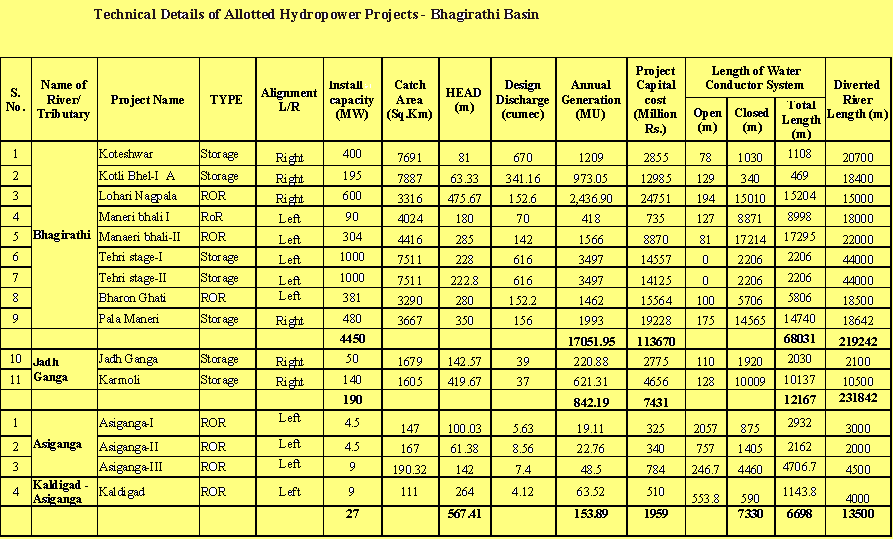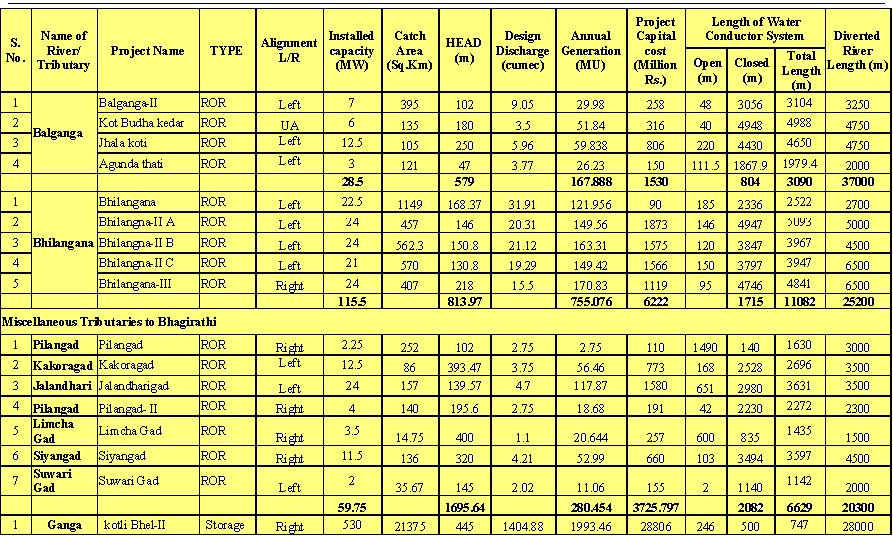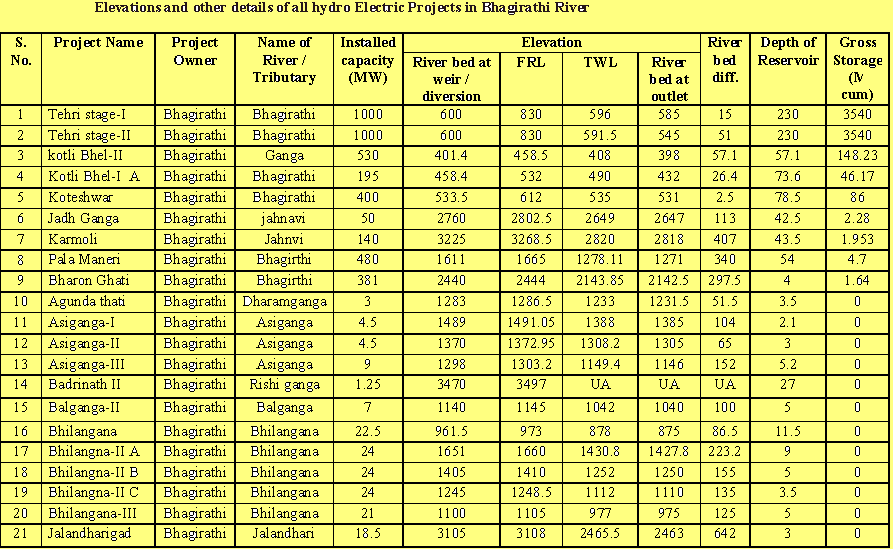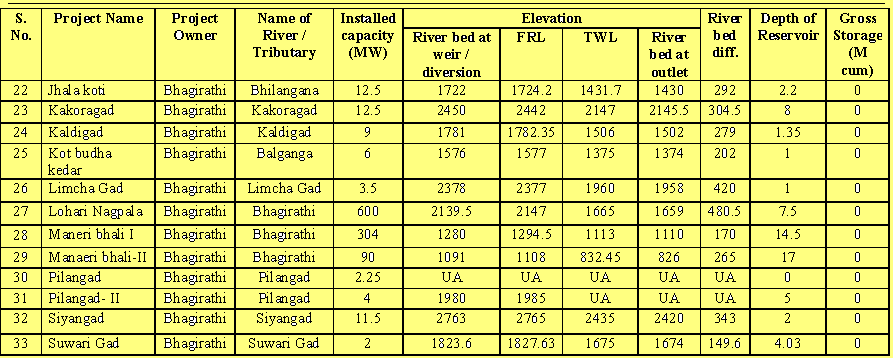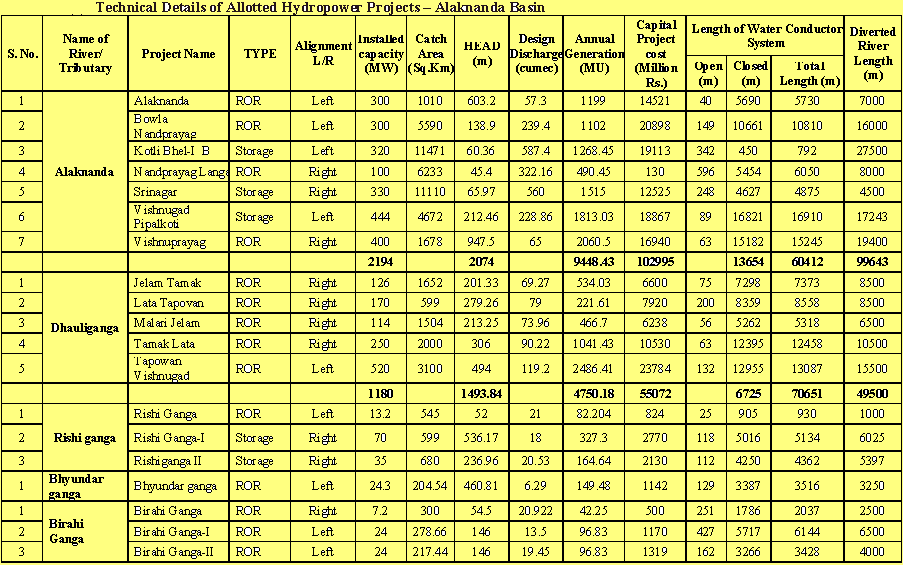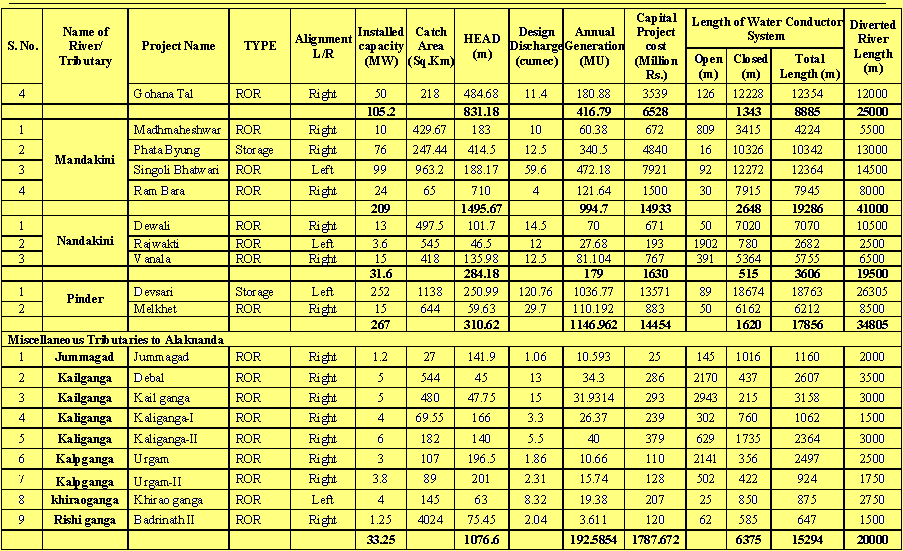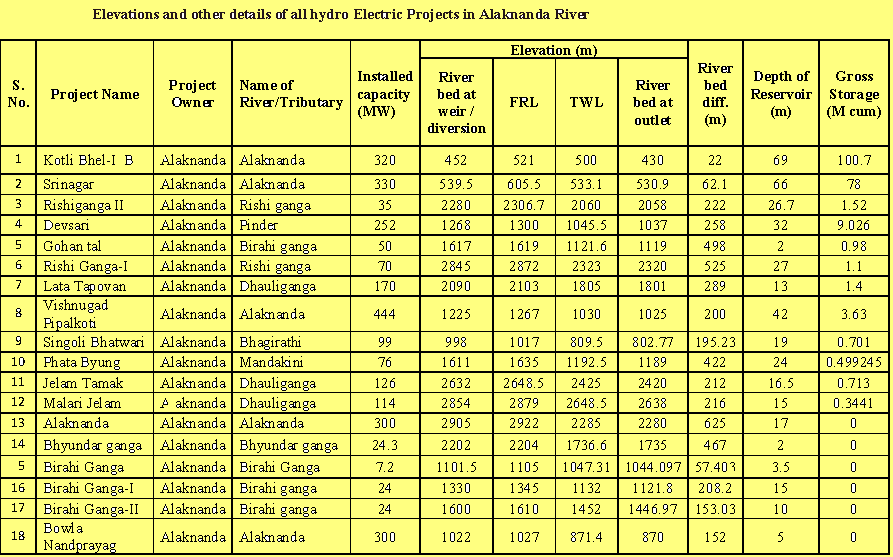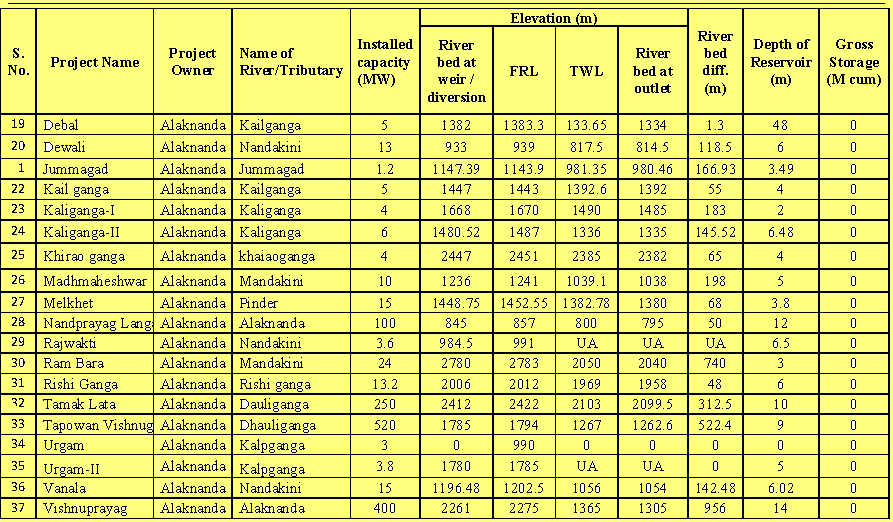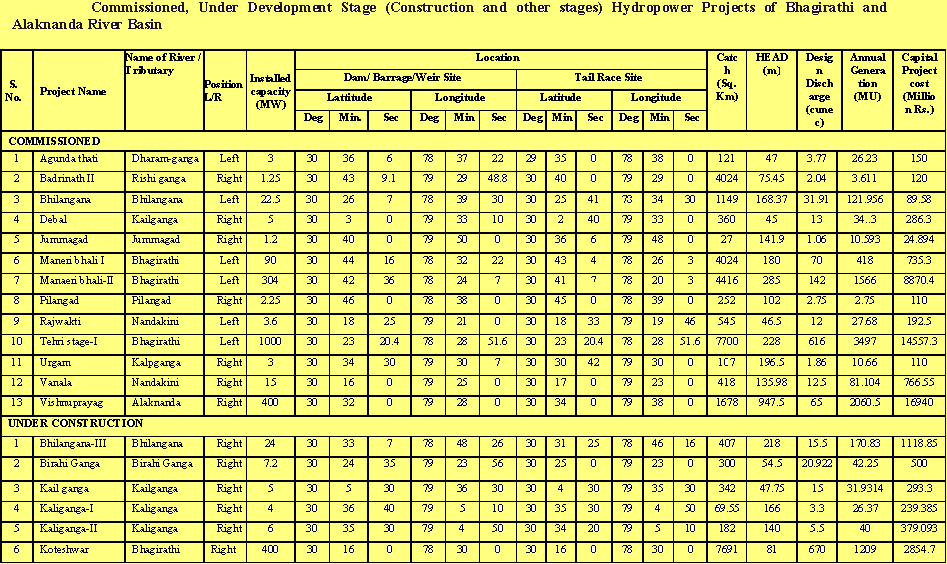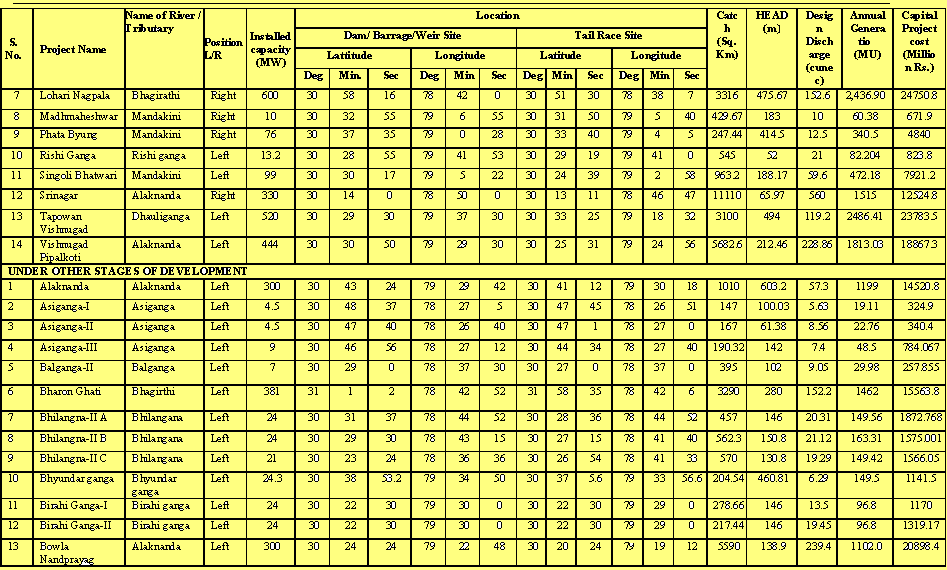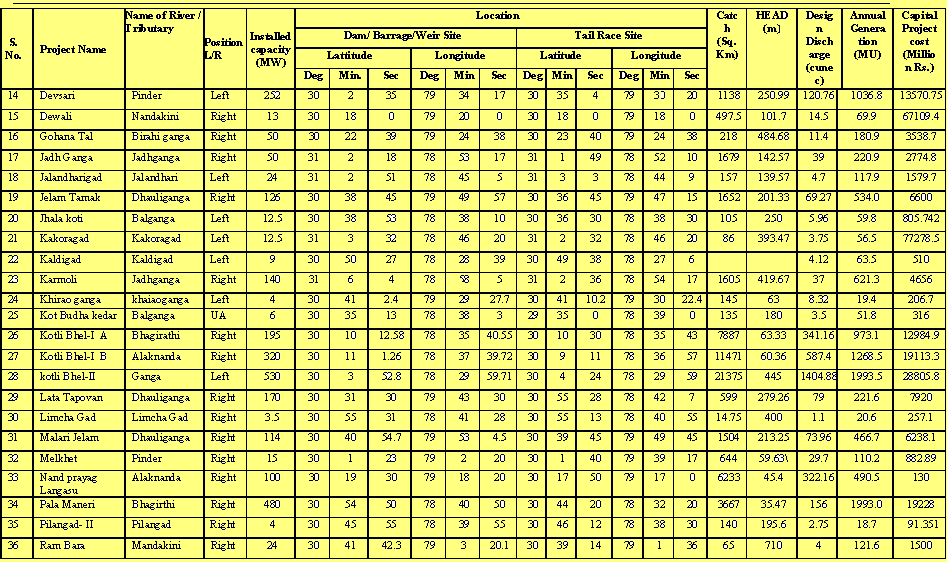|
Hydropower Projects in Ganga Basin With extensive monotonous regions and a multitude of tributaries, the Ganga basin is rich in various projects. According to India-WRIS, basin consists of 39 hydro-electric projects and 56 powerhouses are a testament to the regions importance to India‘s overall hydroelectricity portfolio. There are 27 Major and 12 small hydro-electric projects in the basin. Out of the total 39 hydro-electric projects 29 projects are maintained by State Government, 6 are maintained by Central Government and 4 are maintained by private organization. The hydroelectric projects are owned by many large organizations. The Uttarakhand Jal Vidyut Nigam Ltd. (UJVNL) owns around 9 hydroelectric projects and Uttar Pradesh Jal Vidyut Nigam Ltd. (UPJVNL) owns 5 projects and 4 projects are owned by Madhya Pradesh State Electricity Department/MPPGCL to name some. The maximum installed capacity of the basin is 2000 MW that is installed in Tehri dam by THDC India Ltd.
The Hydro-electric projects are distributed in 9 states in the Ganga basin. There are 14 projects in Uttarakhand, 4 projects in West Bengal, 3 projects in Bihar, 3 projects in Jharkhand, 3 projects in Madhya Pradesh, 3 projects in Uttar Pradesh, 2 projects in Haryana. There are 5 interstate hydro-electric projects are there in Ganga basin, Yamuna Hydroelectric Project with Himachal Pradesh and Uttarakhand, Chambal Hydroelectric Project with Madhya Pradesh and Rajasthan, Rajghat Hydroelectric Project , Matatila Hydroelectric Project and Rihand Hydroelectric Project between Madhya Pradesh and Uttar Pradesh.
The Ganga basin has 56 power houses and their geographical locations are shown sub-basin wise in the maps from Map 16.a to Map 16.s. The Yamuna upper sub-basin contains the maximum number of power houses of about 14 power houses where five in Uttarakhand, four are in Himachal Pradesh, four in Haryana and one in Uttar Pradesh. The Yamuna Lower sub-basin has three power houses where two are in Madhya Pradesh namely Matatila (UPJVNL) and Madikheda Power House (MPPGCL) and Rajghat Power House in Uttar Pradesh maintained by MPSEB/MPPGCL. The above Ramganga confluence sub-basin has 11 power houses all falling in Uttarakhand state with the largest Tehri Power House maintained by THDC India Ltd. The Sone sub-basin has 7 power houses, three in Madhya Pradesh; two in Uttar Pradesh and one each in Jharkhand and Bihar. The Bhagirathi and other sub-basin have four power houses, with three located in West Bengal and Massanjore Power house located at Jharkhand. The Chambal upper basin has only two power houses, i.e. Gandhi Sagar Power house in Madhya Pradesh and Rana Pratap Sagar Power house in Rajasthan. The Damodar sub-basin has four power houses out of which three are in Jharkhand and Panchet Hill Power house is located in West Bengal. The Ghaghara sub-basin has three power houses all located in Uttarakhand out of which two are maintained by NHPC and one is maintained by UJVNL. There are two power houses in the Ghaghara confluence to Gomti confluence sub-basin both maintained by Bihar State Hydro-electric Power Cooperation Ltd. The Tons sub-basin also has two powers Stage- I & II Bansagar in Madhya Pradesh. The Kali Sindh and others up to Confluence with Parbati sub-basin, Kosi sub-basin and Ramganga sub-basin has each power house namely Jawahar Sagar Power House in Rajasthan, Kosi (East Canal) Power House maintained by Bihar State Electricity Board and Ramganga Power House maintained by UJVNL respectively.
The hydroelectric potential of the Ganga basin has been assessed 20711 MW. Out of the 142 identified schemes in the basin , schemes with a total installed capacity of 4987 MW are in operation as on 31.7.2014 and schemes with an installed capacity of about 1751 MW are in various stages of construction. (Source: www.cea.nic.in )
Originating from the Gangotri glacier at Gaumukh, Bhagirathi flows past the Gangotri town and downstream of it, it is joined by Jadh Ganga. Two HP projects, namely Karmoli (140 MW) and Jadh Ganga (50 MW) are under development on this tributary. Bharon Ghati project (38 MW) is located some distance downstream of junction of Bhagirathi and Jadh Ganga. Further downstream, three small tributaries join the Bhagirathi River and one project each, namely Kakora Gad (12.5 MW), Jalandhari Gad (24 MW) and Siyangad (11.5 MW) are under development.
Downstream of the confluence of Bhagirathi with Siyan Gad is the Loharinag Pala (600 MW) RoR project. Currently, the work on this project is under suspension. A small stream namely, Limcha gad joints from left and a small RoR project of 4 MW capacity with same name is under development on this river. Flowing further downstream is the site of Pala Maneri, a RoR project with 480 MW installed capacity.
Further down, two more small streams Suwari gad and Pilangad join Bhagirathi. On Pilan Gad, a project by the name Pilangad (4 MW) is operational and Pilangad-II (4 MW) is under development. Maneri Bhali I HP, which is a RoR of 90 MW capacity is located some distance upstream of the confluence of Bhagirathi and Asiganga.
In the Asiganga sub-basin, four RoR projects, namely Kaldigad (9 MW), Asiganga-1 (4.5 MW), Asiganga-II (4.5 MW) and Asiganga-III (9 MW) are under development. The town of Uttarkashi is located downstream of confluence of Asiganga and Bhagirathi. Downstream of the confluence is another RoR project Maneri Bhali-II whose installed capacity is 304 MW commissioned in 2008.
Bhilangana is the biggest tributary of Bhagirathi which joints it close to the erstwhile old Tehri town. A cascade of HEPs are under development on Bhilangana. From upstream to downstream, these are Bhilangana III (24 MW), Bhilangana II A (24 MW), Bhilangana II B (24 MW), and Bhilanga II C (21 MW) and (23 MW, in operation). Agunda Thati (3 MW) is in operation on a tributary of Bhilangana and Jhala Koti (13 MW) and Balganga II are under development.
Tehri dam is the largest multipurpose project in the study area. Its reservoir has a gross storage capacity of 7400 million m and 2615 million m as live storage. It's power house has four untis of 250 MW each. The project was completed in the year 2006. Downstream of Tehri Dam is the Tehri Stage II project of 1000 MW capacity.
Another project in the close vicinity downstream is the Koteshwar HP of 400 MW capacity. The reservoir of the Koteshwar project will act as a pump back lake for Tehri pump storage project. Kotli Bhel 1A is the last project on Bhagirathi before its meets Alaknanda at Dev Prayag.
Installed capacity of 1422 MW has been developed and 3449 MW (13,620 MU) is under development in Bhagirathi Basin as on March 2011.
Hydropower Projects in Alaknanda River Alaknanda River originates from Satopanth Glacier. It flows past the holy town of Badrinath and a few km downstream is the commissioned Badrinath small scale HP of 1.2 MW capacity with discharge from a small tributaory Rishiganga. The first project under development on this river is Alaknanda HP (300 MW). A small tributary by the name Khirao Ganga joins the Alaknanda River in the course of this project and a small HP of 4 MW by the same name is under development on this tributary.
Vishnuprayag project of 400 MW is the first major RoR project commissioned on Alaknanda. A few kilometer downstream of diversion site of this project, Bhyunder Ganga joins Alaknanda. A small project of 24.5 MW capacity is under development in this stream. Further downstream is the first famous Prayag confluence) of Alaknanda and Dhauli Ganga, is known as Vishnuprayag. A number of HP projects are under development on Dhauli Ganga, including Malari Jelam (114 MW), Jelam Tamak (126 MW), Tamak Lata (250 MW), Lata Tapovan (170 MW), Tapovan Vishnugad (520 MW), Jummagad (Commissioned 1.2 MW), Rishiganga (13.2 MW), Rishi Ganga I (70 MW), Rishi Ganga II (35 MW). The town of Joshimath is situated downstream of Vishnu Prayag. Urgam is a small scale commissioned project of 4 MW on Kalpa Ganga, a tributary of Alaknanda. Vishnugad Pipalkoti project of 444 MW is under development on Alaknanda between the confluence of Kalpa Ganga and Birahi Ganga. Four RoR projects are under development on Birahi Ganga, These are Birahi Ganga I (24 MW), Birahi Ganga II 24 MW), Gohantal (50 MW) and Birahi Ganga (7.2 MW).
Nandakini River joins Alaknanda at Nandprayag, Bowala Nandprayag project of (300 MW) is under development on main Alaknanda, upstream of Nand Prayag. Two projects namely, Vanala (15 MW) and Rajwakti (4 MW) have been commissioned on Nandakini and Dewali (13 MW) is under development. Nandprayag Langasu project of 100 MW is under development on Alaknanda River downstream of Nand Prayag.
Pindar is a tributary of Alaknanda which has a high water potential. Debal project of 5 MW has been commissioned on Kaliganga which is Pindar's tributary. Three projects which are under development in this sub basin are Melkhet (15 MW), Kali Ganga (5 MW), and Devsari (252 MW).
Mandakini is the last major tributary of Alaknanda which joins it at Rudra Prayag. Originating near the famous Shrine of Kedarnath, Mandakini is joined by tributaries such as Kali Ganga and Madmaheshwar. Projects under development in this sub basin are Kaliganga I & II, Madmaheshwar (15 MW), Rambara (24 MW), Phata Byung (76 MW) and Singoli Bhatwari (99 MW). Kotli Bhel I-B is the last HP on Alaknanda before its confluence with Bhagirathi at Devprayag. Near the town of Srinagar, a project by the same name and with an installed capacity of 330 MW is under construction
Overall, the commissioned hydropower potential of Alaknanda is 429 MW and 3734 MW (15,513 MU) is under development.
(Source : AHEC, IIT, Roorkee)
| ||||||||||||
